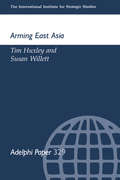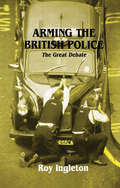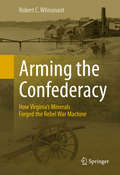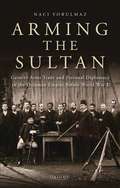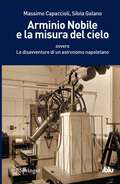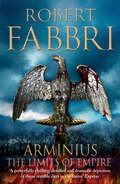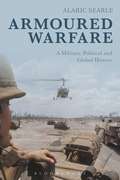- Table View
- List View
Armies without Nations: Public Violence and State Formation in Central America, 1821-1960
by Robert H. HoldenPublic violence, a persistent feature of Latin American life since the collapse of Iberian rule in the 1820s, has been especially prominent in Central America. Robert H. Holden shows how public violence shaped the states that have governed Costa Rica, El Salvador, Guatemala, Honduras, and Nicaragua. Linking public violence and patrimonial political cultures, he shows how the early states improvised their authority by bargaining with armed bands or montoneras. Improvisation continued into the twentieth century as the bands were gradually superseded by semi-autonomous national armies, and as new agents of public violence emerged in the form of armed insurgencies and death squads. World War II, Holden argues, set into motion the globalization of public violence. Its most dramatic manifestation in Central America was the surge in U.S. military and police collaboration with the governments of the region, beginning with the Lend-Lease program of the 1940s and continuing through the Cold War. Although the scope of public violence had already been established by the people of the Central American countries, globalization intensified the violence and inhibited attempts to shrink its scope. Drawing on archival research in all five countries as well as in the United States, Holden elaborates the connections among the national, regional, and international dimensions of public violence. Armies Without Nations crosses the borders of Central American, Latin American, and North American history, providing a model for the study of global history and politics. Armies without Nations was a CHOICE Outstanding Academic Title for 2005.
Arming East Russia (Adelphi series)
by Tim Huxley Susan WillettDuring the 1990s, military spending, arms procurement and defence industrialisation have all increased rapidly in East Asia. Although these developments do not constitute an arms race, they nevertheless have important implications for suppliers of defence equipment, for arms control and for regional stability. This paper assesses trends in the defence spending of East Asian states, particularly in the light of the economic crisis, which began in mid-1997. It also focuses on three closely-related issues: the nature of the regional market for defence equipment; defence industrialisation; and the effect of trends in defence procurement and industrialisation on East Asian states' military capabilities, and on the regional military balance.
Arming East Russia (Adelphi series)
by Tim Huxley Susan WillettDuring the 1990s, military spending, arms procurement and defence industrialisation have all increased rapidly in East Asia. Although these developments do not constitute an arms race, they nevertheless have important implications for suppliers of defence equipment, for arms control and for regional stability. This paper assesses trends in the defence spending of East Asian states, particularly in the light of the economic crisis, which began in mid-1997. It also focuses on three closely-related issues: the nature of the regional market for defence equipment; defence industrialisation; and the effect of trends in defence procurement and industrialisation on East Asian states' military capabilities, and on the regional military balance.
The Arming of Europe and the Making of the First World War (Princeton Studies In International History And Politics)
by David G. HerrmannDavid Herrmann's work is the most complete study to date of how land-based military power influenced international affairs during the series of diplomatic crises that led up to the First World War. Instead of emphasizing the naval arms race, which has been extensively studied before, Herrmann draws on documentary research in military and state archives in Germany, France, Austria, England, and Italy to show the previously unexplored effects of changes in the strength of the European armies during this period. Herrmann's work provides not only a contribution to debates about the causes of the war but also an account of how the European armies adopted the new weaponry of the twentieth century in the decade before 1914, including quick-firing artillery, machine guns, motor transport, and aircraft. In a narrative account that runs from the beginning of a series of international crises in 1904 until the outbreak of the war, Herrmann points to changes in the balance of military power to explain why the war began in 1914, instead of at some other time. Russia was incapable of waging a European war in the aftermath of its defeat at the hands of Japan in 1904-5, but in 1912, when Russia appeared to be regaining its capacity to fight, an unprecedented land-armaments race began. Consequently, when the July crisis of 1914 developed, the atmosphere of military competition made war a far more likely outcome than it would have been a decade earlier.
Arming Slaves: From Classical Times to the Modern Age (The David Brion Davis Series)
by Christopher Leslie Brown Philip D. MorganArming slaves as soldiers is a counterintuitive idea. Yet throughout history, in many varied societies, slaveholders have entrusted slaves with the use of deadly force. This book is the first to survey the practice broadly across space and time, encompassing the cultures of classical Greece, the early Islamic kingdoms of the Near East, West and East Africa, the British and French Caribbean, the United States, and Latin America.To facilitate cross-cultural comparisons, each chapter addresses four crucial issues: the social and cultural facts regarding the arming of slaves, the experience of slave soldiers, the ideological origins and consequences of equipping enslaved peoples for battle, and the impact of the practice on the status of slaves and slavery itself. What emerges from the book is a new historical understanding: the arming of slaves is neither uncommon nor paradoxical but is instead both predictable and explicable.
Arming the British Police: The Great Debate
by Roy IngletonAs the fear of violent crime escalates, there are calls for the police to carry guns. This examination of the history of violent crime and violence against the representatives of law and order looks at the extent to which the "unarmed" British police have had recourse to firearms in the past.
Arming the British Police: The Great Debate
by Roy IngletonAs the fear of violent crime escalates, there are calls for the police to carry guns. This examination of the history of violent crime and violence against the representatives of law and order looks at the extent to which the "unarmed" British police have had recourse to firearms in the past.
Arming the Confederacy: How Virginia’s Minerals Forged the Rebel War Machine
by Robert C. WhisonantThis is a fresh look at the American Civil War from the standpoint of the natural resources necessary to keep the armies in the field. This story of the links between minerals, topography, and the war in western Virginia now comes to light in a way that enhances our understanding of America’s greatest trial. Five mineral products – niter, lead, salt, iron, and coal – were absolutely essential to wage war in the 1860s. For the armies of the South, those resources were concentrated in the remote Appalachian highlands of southwestern Virginia. From the beginning of the war, the Union knew that the key to victory was the destruction or occupation of the mines, furnaces, and forges located there, as well as the railroad that moved the resources to where they were desperately needed. To achieve this, Federal forces repeatedly advanced into the treacherous mountainous terrain to fight some of the most savage battles of the War.
Arming the Free World: The Origins of the United States Military Assistance Program, 1945-1950
by Chester J. PachIn this important study, Chester Pach traces the emergence of military assistance as a major instrument of contemporary American foreign policy. During the early Cold War, arms aid grew from a few country and regional programs into a worldwide effort with an annual cost of more than $1 billion. Pach analyzes the Truman administration's increasing reliance on arms aid--for Latin America, Greece and Turkey, China, and Western Europe--to contain Communist expansion during the late 1940s. He shows that a crucial event was the passage of the Mutual Defense Assistance Act of 1949, the progenitor of a long series of global, Cold War arms measures.Pach demonstrates that the main impetus for the startling growth of military assistance was a belief that it would provide critical political and psychological reassurance to friendly nations. Although this aid was ostensibly provided for military purposes, the overriding goals were insuring goodwill, raising foreign morale, stiffening the will to resist communism, and proving American resolve and reliability.Policymakers, Pach contends, confused means with ends by stressing the symbolic importance of furnishing aid. They sought additional appropriations with the threat that any diminution or cessation of aid suggested a weakening of American commitment. Pach reveals that civilian, not military, officials were the principal advocates of the expansion of military aid, and he shows how the policies established during the Truman administration continued to exert a profound influence throughout the Cold War.Some officials questioned the self-perpetuating qualities of military aid programs, but Pach concludes that their warnings went unheeded. Although fiscal restraints in the Truman administration temporarily stemmed the growth of aid, the Korean War exploded budgetary limitations. MIlitary assistance spending expanded rapidly in size and scope, gaining a momentum that succeeding administrations could not resist.Originally published in 1991.A UNC Press Enduring Edition -- UNC Press Enduring Editions use the latest in digital technology to make available again books from our distinguished backlist that were previously out of print. These editions are published unaltered from the original, and are presented in affordable paperback formats, bringing readers both historical and cultural value.
Arming the Periphery: The Arms Trade in the Indian Ocean during the Age of Global Empire
by E. ChewA major historical study of the global arms trade, revolving around the transfer of small arms from metropolitan Europe to the turbulent frontiers of Indian Ocean societies during the 'long' nineteenth century (c.1780-1914).
Arming the Royal Navy, 1793–1815: The Office of Ordnance and the State (Warfare, Society and Culture)
by Gareth ColeThe Office of Ordnance has been ill-served by previous accounts of its role in arming the Royal Navy during the French Revolution and Napoleonic Wars. Cole offers an in-depth examination of its organizational structure and demonstrates how the department responded to the pressures of war over an extended period of time.
Arming the Royal Navy, 1793–1815: The Office of Ordnance and the State (Warfare, Society and Culture #4)
by Gareth ColeThe Office of Ordnance has been ill-served by previous accounts of its role in arming the Royal Navy during the French Revolution and Napoleonic Wars. Cole offers an in-depth examination of its organizational structure and demonstrates how the department responded to the pressures of war over an extended period of time.
Arming the Sultan: German Arms Trade and Personal Diplomacy in the Ottoman Empire Before World War I (Library of Ottoman Studies)
by Naci YorulmazAt the beginning of the nineteenth century, the Ottoman armaments trade was entirely self-sufficient. But by the end of the century, it was almost entirely under German control. How did Germany under Chancellor Bismarck manage to conquer what had until then been an extremely competitive military market? Focusing on the reign of Sultan Abdülhamid between 1876 and 1909, Naci Yorulmaz's book explores the determining factors that influenced the development of the Ottoman armaments market. While acknowledging the importance of political and economic factors, Arming the Sultan concentrates on the personal relationships which shaped the development of the arms trade, including the bonds between arms-makers and the government, between German politicians and Ottoman grandees, and even the private relationships between Kaiser Wilhelm I, Otto von Bismarck and the Sultan. Yorulmaz's innovative book suggests that the value of these relationships has been overlooked, and ensured German success over British, French and American competition.
Arming the Western Front: War, Business and the State in Britain 1900–1920 (Routledge Studies in First World War History)
by Roger Lloyd-Jones M.J. LewisThe First World War was above all a war of logistics. Whilst the conflict will forever be remembered for the mud and slaughter of the Western Front, it was a war won on the factory floor as much as the battlefield. Examining the war from an industrial perspective, Arming the Western Front examines how the British between 1900 and 1920 set about mobilising economic and human resources to meet the challenge of 'industrial war'. Beginning with an assessment of the run up to war, the book examines Edwardian business-state relations in terms of armament supply. It then outlines events during the first year of the war, taking a critical view of competing constructs of the war and considering how these influenced decision makers in both the private and public domains. This sets the framework for an examination of the response of business firms to the demand for 'shells more shells', and their varying ability to innovate and manage changing methods of production and organisation. The outcome, a central theme of the book, was a complex and evolving trade-off between the quantity and quality of munitions supply, an issue that became particularly acute during the Battle of the Somme in 1916. This deepened the economic and political tensions between the military, the Ministry of Munitions, and private engineering contractors as the pressure to increase output accelerated markedly in the search for victory on the western front. The Great War created a dual army, one in the field, the other at home producing munitions, and the final section of the book examines the tensions between the two as the country strove for final victory and faced the challenges of the transition to the peace time economy.
Arming the Western Front: War, Business and the State in Britain 1900–1920 (Routledge Studies in First World War History)
by Roger Lloyd-Jones M.J. LewisThe First World War was above all a war of logistics. Whilst the conflict will forever be remembered for the mud and slaughter of the Western Front, it was a war won on the factory floor as much as the battlefield. Examining the war from an industrial perspective, Arming the Western Front examines how the British between 1900 and 1920 set about mobilising economic and human resources to meet the challenge of 'industrial war'. Beginning with an assessment of the run up to war, the book examines Edwardian business-state relations in terms of armament supply. It then outlines events during the first year of the war, taking a critical view of competing constructs of the war and considering how these influenced decision makers in both the private and public domains. This sets the framework for an examination of the response of business firms to the demand for 'shells more shells', and their varying ability to innovate and manage changing methods of production and organisation. The outcome, a central theme of the book, was a complex and evolving trade-off between the quantity and quality of munitions supply, an issue that became particularly acute during the Battle of the Somme in 1916. This deepened the economic and political tensions between the military, the Ministry of Munitions, and private engineering contractors as the pressure to increase output accelerated markedly in the search for victory on the western front. The Great War created a dual army, one in the field, the other at home producing munitions, and the final section of the book examines the tensions between the two as the country strove for final victory and faced the challenges of the transition to the peace time economy.
Arminio Nobile e la misura del cielo: ovvero Le disavventure di un astronomo napoletano (I blu)
by Massimo Capaccioli Silvia GalanoLa scienza è un’esaltante avventura che è costume raccontare attraverso le gesta dei grandi. Esiste però un’altra storia, altrettanto avvincente ma con poca voce, scritta dai tanti gregari e potenziali campioni cui la sorte, spesso nemmeno troppo cieca, ha negato la gloria. Questo libro parla di uno di loro e del suo piccolo mondo sulla collina di Capodimonte, a Napoli. È la parabola di Arminio Nobile – personaggio notevole eppure poco noto dell’astronomia italiana – svolta sulla scena della nascente astrofisica, in una stagione di grandi transizioni per il Mezzogiorno. Arminio, che era figlio di Giuseppina Guacci, figura di spicco della cultura pre-risorgimentale, e di un valente astronomo della Specola di Capodimonte, scelse di votarsi allo studio del cielo. Osservatore instancabile, appassionato e genialoide, aveva le carte in regola e le motivazioni per “sfondare”, ma la fortuna non gli arrise: più volte si beffò di lui, spingendolo su vicoli ciechi che la sua testardaggine gli impedì di abbandonare. Così, quando la grande occasione gli si parò davanti, la riconobbe ma non seppe coglierla appieno, morendo “disperato” come il pucciniano amante di Tosca.
Arminius: The Limits of Empire
by Robert FabbriOne man's greatest victory.Rome's greatest defeat.A.D. 9: In the depths of the Teutoburg Wald, in a landscape riven by ravines, darkened by ancient oak and bisected by fast-flowing streams, Arminius of the Cherusci led a confederation of six Germanic tribes in the annihilation of three Roman legions. Deep in the forest almost twenty thousand men were massacred without mercy; fewer than two hundred of them ever made it back across the Rhine. To Rome's shame, three sacred Eagles were lost that day.But Arminius wasn't brought up in Germania Magna - he had been raised as a Roman. This is the story of how Arminius came to turn his back on the people who raised him and went on to commit a betrayal so great and so deep, it echoed through the ages.______________________________________________Don't miss Robert Fabbri's epic new series Alexander's Legacy
Arminius the Liberator: Myth and Ideology
by Martin M. WinklerArminius the Liberator deals with the complex modern reception of Arminius the Cheruscan, commonly called Hermann. Arminius inflicted one of their most devastating defeats on the Romans in the year 9 A.D. by annihilating three legions under the command of Quintilius Varus in the Battle of the Teutoburg Forest, as it is generally if inaccurately called. This book traces the origin of the Arminius myth in antiquity and its political, artistic, and popular developments since the nineteenth century. The book's central themes are the nationalist use and abuse of history and historical myth in Germany, especially during the Weimar Republic and National Socialism, the reactions to a discredited ideology involving Arminius in post-war Europe, and revivals of his myth in the United States. Special emphasis is on the representation of Arminius in visual media since the 1960s: from painting and theater to cinema, television, and computer animation.
Armored Units of the Russian Civil War: Red Army (New Vanguard)
by Peter Sarson David BullockBy 1920 the Red Army of Russia fielded an overwhelming array of armored cars, armored trains and tank detachments. These armored units played an important part in consolidating the newly won Bolshevik empire in the early 1920s; as a consequence of the fact that railways were the strategic arteries that essentially controlled Russia, armored trains have never played such a significant role in military history as they did in the Russian Civil War. This title details the management, construction, repair, personnel, training and combat of the Red Army's armored units on all fronts, including such famous vehicles as Trotsky's armored train.
Armored Units of the Russian Civil War: Red Army (New Vanguard #95)
by Peter Sarson David BullockBy 1920 the Red Army of Russia fielded an overwhelming array of armored cars, armored trains and tank detachments. These armored units played an important part in consolidating the newly won Bolshevik empire in the early 1920s; as a consequence of the fact that railways were the strategic arteries that essentially controlled Russia, armored trains have never played such a significant role in military history as they did in the Russian Civil War. This title details the management, construction, repair, personnel, training and combat of the Red Army's armored units on all fronts, including such famous vehicles as Trotsky's armored train.
Armour Never Wearies: Scale and Lamellar Armour in the West, from the the Bronze Age to the 19th Century
by Timothy DawsonArmour Never Wearies is the first volume to bring together all the hitherto scattered evidence – archaeological, literary and artistic – for the forms and uses of scale and lamellar armours in the region west of the Ural Mountains throughout the 3,500 years during which these armours were used. The interpretation of this data is informed by the author’s long practical experience as a maker of arms and armour, martial artist and horseman. It offers systematic definitions and analysis of these often misunderstood forms of armour, along with detailed diagrams and instructions that will be of great use to any who wish to turn their hands to reconstruction. Along the way, this unique synthesis of evidence and interpretation debunks some myths that have arisen in recent years.
The Armour of Light: A page-turning and epic Kingsbridge novel from the internationally bestselling author of The Pillars of The Earth (The Kingsbridge Novels #5)
by Ken FollettThe grand master of gripping fiction is back. International No.1 bestseller Ken Follett returns to Kingsbridge with an epic tale of revolution and a cast of unforgettable characters.Revolution is in the air1792. A tyrannical government is determined to make England a mighty commercial empire. In France, Napoleon Bonaparte begins his rise to power, and with dissent rife, France’s neighbours are on high alert.Kingsbridge is on the edgeUnprecedented industrial change sweeps the land, making the lives of the workers in Kingbridge’s prosperous cloth mills a misery. Rampant modernization and dangerous new machinery are rendering jobs obsolete and tearing families apart.Tyranny is on the horizonNow, as international conflict nears, a story of a small group of Kingsbridge people – including spinner Sal Clitheroe, weaver David Shoveller and Kit, Sal’s inventive and headstrong son – will come to define the struggle of a generation as they seek enlightenment and fight for a future free from oppression . . .Taking the reader straight into the heart of history with the fifth novel in the ground-breaking Kingsbridge series, The Armour of Light is master storyteller Ken Follett’s most ambitious novel to date.'Follett's storytelling skills make their adventures riveting' - The Times'An effortlessly engaging and entertaining read' - Daily Mail'Bold in scale and meticulously researched' - The Sunday Times'The plague scenes are expertly handled. Where Follett excels is in telling a yarn' - IndependentMore than 175 million copies sold worldwide. Published in over eighty territories and thirty-seven languages. The international no.1 bestselling phenomenon returns.
The Armoured Campaign in Normandy: June - August 1944
by Stephen NapierBeginning with the D-day landings, this is a frank appraisal of the planned use and actual results of the deployment of armour by both German and Allied commanders in the major tank battles of the campaign including Epsom, Goodwood, Cobra and Totalize. ‘Tiger!’ is a critique of how Montgomery’s plans to seize territory and break out failed in the face of German resistance. It details the poor planning by British generals who made many mistakes and how the German convoluted chain of command contributed to their own defeat. Official reports, war diaries, After Action reports, letters, regimental histories, memoirs of generals and troopers are used to tell the inside story of the campaign from an armour point of view to give a different but detailed perspective. For the first time the book gives real numbers of tanks lost in the battle of the campaign from research at archives around the world.
Armoured Warfare: A Military, Political and Global History
by Alaric SearleThis book charts the history of armoured warfare from the first use of the tank in 1916 right through to the 21st century, adopting military, political and global perspectives. Alaric Searle explores the origins of the tank, the part it played in the First World War and its contribution to the outcome of the war. He considers its role as a tool of propaganda, the military controversies of the interwar period and the employment of armoured forces in all the major theatres in the Second World War.Since the First World War, major and medium-sized powers have invested heavily in armoured forces. Searle looks at the conduct of mechanised warfare in Korea, Indo-China and Vietnam, and during conflicts such as the Arab-Israeli Wars and the Gulf Wars. Armoured Warfare adopts a global perspective, providing the most comprehensive survey of the history of the subject currently available. With a detailed bibliography of both primary and secondary sources, it is an ideal companion for those studying armoured warfare, modern military history and war studies.
Armoured Warfare: A Military, Political and Global History
by Alaric SearleThis book charts the history of armoured warfare from the first use of the tank in 1916 right through to the 21st century, adopting military, political and global perspectives. Alaric Searle explores the origins of the tank, the part it played in the First World War and its contribution to the outcome of the war. He considers its role as a tool of propaganda, the military controversies of the interwar period and the employment of armoured forces in all the major theatres in the Second World War.Since the First World War, major and medium-sized powers have invested heavily in armoured forces. Searle looks at the conduct of mechanised warfare in Korea, Indo-China and Vietnam, and during conflicts such as the Arab-Israeli Wars and the Gulf Wars. Armoured Warfare adopts a global perspective, providing the most comprehensive survey of the history of the subject currently available. With a detailed bibliography of both primary and secondary sources, it is an ideal companion for those studying armoured warfare, modern military history and war studies.

